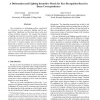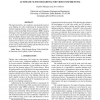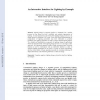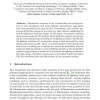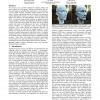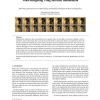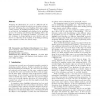145
click to vote
CVPR
2011
IEEE
14 years 9 months ago
2011
IEEE
Face recognition is a challenging problem, complicated by variations in pose, expression, lighting, and the passage of time. Significant work has been done to solve each of these...
113
click to vote
ICIP
2009
IEEE
14 years 10 months ago
2009
IEEE
This paper describes a new method to automatically improve scene lighting for video conferencing by learning the photometric mapping between a lower exposure and desired exposure ...
104
click to vote
SG
2010
Springer
14 years 10 months ago
2010
Springer
Lighting design in computer graphics is essentially not a random process but one driven by both a technical and aesthetic appreciation of lighting. In some applications, the result...
168
click to vote
ECCV
2010
Springer
14 years 11 months ago
2010
Springer
Abstract. Illumination variation is one of intractable yet crucial problems in face recognition and many lighting normalization approaches have been proposed in the past decades. N...
109
click to vote
TOG
2002
15 years 16 days ago
2002
We present a new, real-time method for rendering diffuse and glossy objects in low-frequency lighting environments that captures soft shadows, interreflections, and caustics. As a...
120
click to vote
CGA
1998
15 years 18 days ago
1998
A whole variety of different techniques for simulating global illumination in virtual environments have been developed over recent years. Each technique, including Radiosity, Mont...
117
click to vote
CIE
2004
Springer
15 years 23 days ago
2004
Springer
Recent advances in computer graphics, particularly in real-time rendering, have caused major improvements in 3D graphics and rendering techniques used in interactive entertainment...
122
click to vote
IJVR
2006
15 years 27 days ago
2006
This work presents an approach to render appropriate shadows with Image Based Lighting in Augmented Reality applications. To approximate the result of environment lighting and shad...
CGF
2008
15 years 1 months ago
2008
Inappropriate lighting is often responsible for poor quality video. In most offices and homes, lighting is not designed for video conferencing. This can result in unevenly lit fac...
137
click to vote
SI3D
1992
ACM
15 years 5 months ago
1992
ACM
Designing the illumination of a scene is a di cult task because one needs to render the whole scene in order to look at the result. Obtaining the correct lighting e ects may requi...
